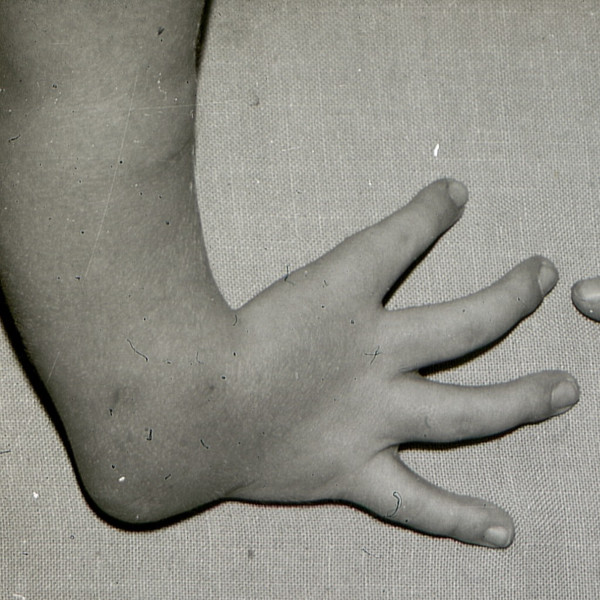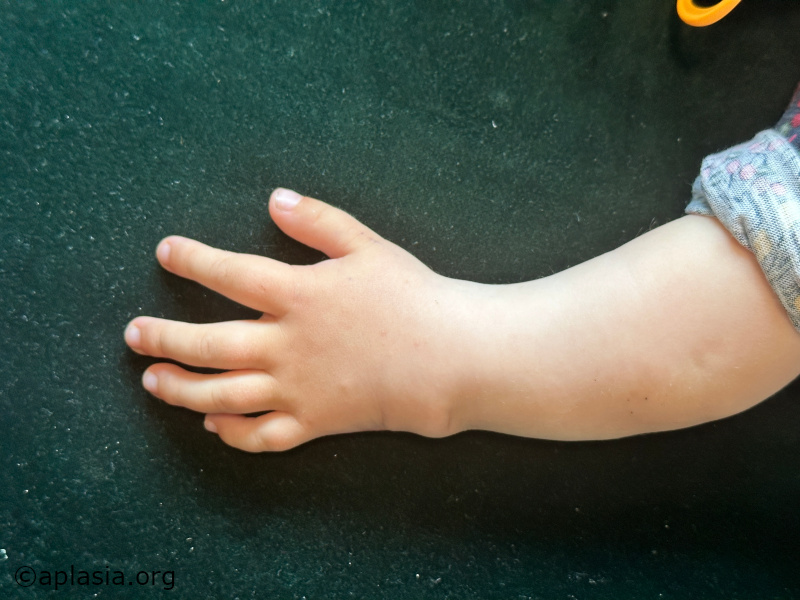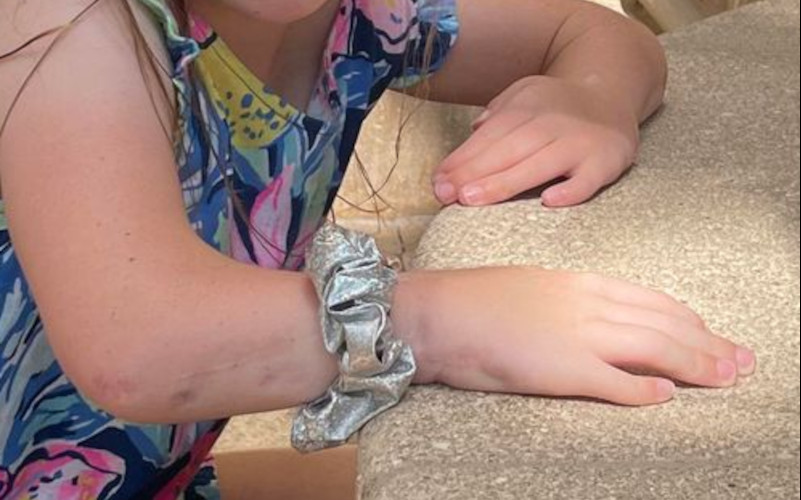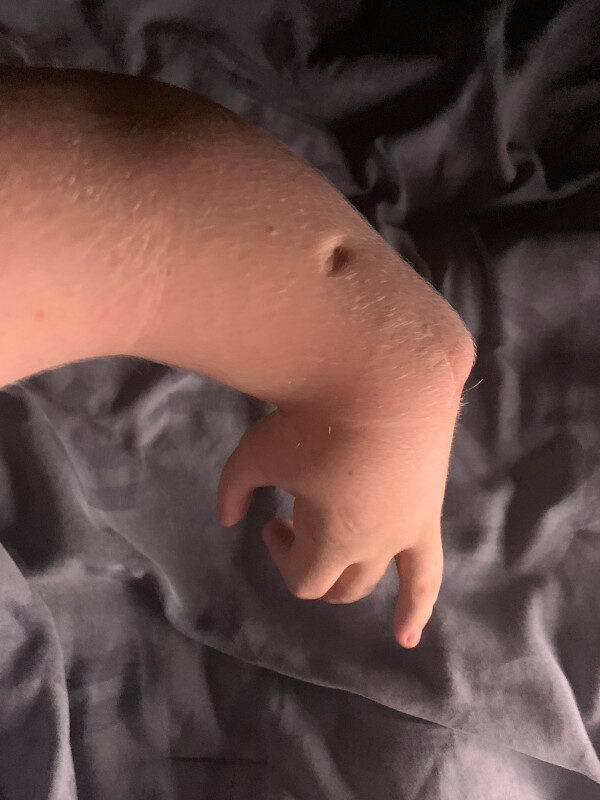Treatment of RADIAL APLASIA
Considerations
In December 2023
Radial Aplasia – especially with thumbs present – is a rare medical condition. Deciding how to treat the resulting radial deviation of the hand – or, in some instances, whether to intervene at all – is challenging because the available options are far from ordinary, (almost) always successful procedures.
The most pressing issue for us was recurrence – not only having to deal with radial deviation again but with the additional risk of ending up with an ulnocarpal fusion and/or growth arrest, presumably a worse outcome than not treating the radial deviation at all.
There is no lack of studies finding high recurrence rates in Centralizations. While Radializations have been a significant improvement, a risk of recurrence seems to persist – see, for example, here, here, and here. The surgeons we were recommended to treat our daughter in Germany via Radialization explicitly warned us that recurrence was likely, at least to a certain degree, and almost guaranteed if we did not ensure our daughter would wear splints at night until she was fully grown, around 16 years old. To our knowledge, except for Ulnarization, there are no other promising procedures.
After unsatisfactory results over many years, some institutions have abandoned offering Centralizations and Radializations altogether and settled on less intrusive interventions where the recurrence of radial deviation is fully expected (source). Note that this paper from 2020 includes many citations but does not mention Dr. Paley’s or Dr. Standard’s work.
Radialization, a substantial improvement over Centralization, was proposed by Dieter Buck-Gramko in 1985 – almost 40 years ago, and to this day, is the standard procedure in Europe. Ulnarization, while a younger technique, is not a novelty – it dates back to 1999 (Generation 1, which included external fixation). Working on issues that occurred in some patients (like a bump related to the ulnar head becoming prominent on the radial side and gravity-related dynamic ulnar deviation), Dr. Paley started to shorten the ulna during the procedure and switched from external to internal fixation (Generation 2).
Since the shortening did not resolve the «ulna bump» issue, Dr. Paley modified the procedure again in 2019 (releasing a ligament between two carpal bones – scaphoid and lunate – to make room for the ulnar head). This is the now-current Generation 3 (as of December 2023).
Note that none of the three generations of Ulnarization showed recurring deformities or growth arrests. There are many other advantages of Ulnarization over Centralization and Radialization, for instance, requiring fewer surgeries and no external fixation. More details on Ulnarization and images can be found here and here.
We also know about parents who decide not to intervene at all, and there are plenty of instances of children, and then adults, who cope very well with this condition. Since this was never an option for us, we cannot say more about it.

Source: Wikipedia, Mehlauge, License: CC BY-SA 3.0


Why did we chose Dr. Paley's approach of Ulnarization?
Our rationale
As we live in Germany, the likely choice would have been to go with the Radialization procedure offered in most parts of Europe. We have a specialized clinic in Hamburg that provides the procedure, and every other hand surgery department referred us to Hamburg or to Mannheim (which is closer to where we live and where some surgeons from Hamburg built up a new hand surgical department). We went to both and also to Bad Neustadt for consultations.
Ultimately, we decided not to have the surgery in Germany.
We had several reasons, but the main ones were:
- We wanted the best possible treatment for our daughter (no recurrence!) and we were convinced that the results of Ulnarizations we were able to get photos of were superior to those of Radializations – especially after a few years.
- A Radialization procedure would have meant five surgeries (if everything went according to plan). The procedure would have started only after the bones/arms became long enough for the smallest fixators (around 2,5 / 3 years). Our daughter would have had to wear a cast-like night splint for several years (until skeletal maturity was reached). And we would have had a considerable risk of recurrence and re-operations.
How we got there
We read about children who got Radialization surgery and were unhappy with the result (many, of course, were satisfied). We also met a family whose child had Radialization surgery done, with multiple re-operations on one arm, which is why they decided not to do surgery on the second arm.
We found some Facebook groups and talked to many patient-parents who have visited either Dr. Paley or Dr. Standard, and all of them were pleased with the results (Dr. Paley used to work in Baltimore with Dr. Standard but then moved to Florida to establish the Paley Institute). He trained highly-skilled surgeons in Palm Beach and Warsaw to perform Ulnarization procedures (currently Gen 3).

We participated in an online chat Q&A with Dr. Standard, and got the answers to our questions and a cost estimate after sending x-rays and pictures. We sent Dr. Paley detailed questions via e-mail and received answers to all of them. We also got a cost estimate after sending x-rays and images.
Why did we choose Dr. Paley? Firstly, he is constantly improving the technique. Secondly, he offers surgery in Warsaw, Poland, at the Paley European Institute in Europe. Finally, no external fixator is necessary after Ulnarization to hold the position for several weeks.
Looking back
Looking back, we are happy we did not follow the advice of several surgeons in Germany to go to Hamburg for treatment. Yet, it was difficult for us to challenge the recommendations of so many experts at once. All our questions about the work of Drs. Standard and Paley were met with ignorance («never heard of it») or outright dismissal, including something to the effect of: «These Americans are sales guys; they make lots of promises, charge you a lot of money, and afterward you will end up here to get a botched surgery fixed.»
We ended up mainly trusting not any doctors’ statements about Ulnarization but our research and especially the statements of so many parents satisfied with the results. Ultimately, this website’s purpose is to underpin those statements.
It is often said that «nothing spoils good results like good follow-up,» – including by Dr. Paley himself in this worthwhile podcast. It is 15 months since the surgery now, and our daughter’s hands look and function exceptionally well. She is strong and dexterous, and her friends don’t even notice that her arms are a bit «different». No one knows how well this instance of Ulnarization (Gen. 3) will stand the test of time, but the images below show some other results that are already a few years older. More pictures and some videos can be found in our «before and after» picture gallery.




